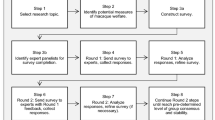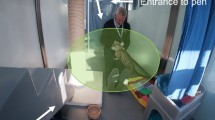Abstract
Data collected from NHPs that are trained to participate voluntarily in husbandry, veterinary, and research procedures are likely to have particular value. The authors present the results of a series of studies that examined the effects of PRT on the performance by chimpanzees of a variety of biomedically relevant behaviors: presenting their perineum for pinworm testing, providing a semen sample, presenting for an s.c. injection, and presenting for an i.m. injection. The overall trends across studies indicate that PRT techniques have significant value in the handling and management of NHPs in many laboratory research settings, including less variability in the data collected and fewer potential confounding variables, which should lead to important refinements in the definition of NHPs as biomedical research models.
This is a preview of subscription content, access via your institution
Access options
Subscribe to this journal
We are sorry, but there is no personal subscription option available for your country.
Buy this article
- Purchase on Springer Link
- Instant access to full article PDF
Prices may be subject to local taxes which are calculated during checkout

Similar content being viewed by others
References
Lambeth, S.P. et al. Positive reinforcement training affects hematologic and serum chemistry values in captive chimpanzees (Pan troglodytes). Am. J. Primatol. 62 (S1), 37–38 (2004).
Prescott, M.J. & Buchanan-Smith, H.M. Training nonhuman primates using positive reinforcement training. J. Appl. Anim. Welfare Sci. 6(3), 157–162 (2003).
Schapiro, S.J., Bloomsmith, M.A. & Laule, G.E. Positive reinforcement training as a technique to alter nonhuman primate behavior: quantitative assessments of effectiveness. J. Appl. Anim. Welfare Sci. 6(3), 175–188 (2003).
McKinley, J., Buchanan-Smith, H.M., Bassett, L. & Morris, K. Training common marmosets (Callithrix jacchus) to cooperate during routine laboratory procedures: ease of training and time investment. J. Appl. Anim. Welfare Sci. 6(3), 209–220 (2003).
Schapiro, S.J., Perlman, J.E. & Boudreau, B.A. Manipulating the affiliative interactions of group-housed rhesus macaques using positive reinforcement training techniques. Am. J. Primatol. 55(3), 137–149 (2001).
Bassett, L., Buchanan-Smith, H.M., McKinley, J. & Smith, T.E. Effects of training on stress-related behavior of the common marmoset (Callithrix jacchus) in relation to coping with routine husbandry procedures. J. Appl. Anim. Welfare Sci. 6(3), 221–233 (2003).
Scott, L., Pearce, P., Fairhall, S., Muggleton, N. & Smith, J. Training nonhuman primates to cooperate with scientific procedures in applied biomedical research. J. Appl. Anim. Welfare Sci. 6(3), 199–208 (2003).
Skinner, B.F. The Behavior of Organisms (Appleton-Century-Crofts, New York, 1938).
Bachevalier, J. et al. Aged monkeys exhibit behavioral deficits indicative of widespread cerebral dysfunction. Neurobiol. Aging 12(2), 99–111 (1991).
Clark, F.C. The effect of deprivation and frequency of reinforcement on variable-interval responding. J. Exp. Analysis Behav. 1, 221–228 (1958).
Cosgrove, K.P. & Carroll, M.E. Effects of bremazocine on self-administration of smoked cocaine base and orally delivered ethanol, phencyclidine, saccharin, and food in rhesus monkeys: a behavioral economic analysis. J. Pharmacol. Exp. Ther. 301(3), 993–1002 (2002).
Taffe, M.A. Effects of parametric feeding manipulations on behavioral performance in macaques. Phys. Beh. 81(1), 59–70 (2004).
Bloomsmith, M.A., Laule, G.E., Alford, P.L. & Thurston, R.H. Using training to moderate chimpanzee aggression during feeding. Zoo Biol. 13(6), 557–566 (1994).
Desmond, T. & Laule G. Use of positive reinforcement training in the management of species for reproduction. Zoo Biol. 13(5), 471–477 (1994).
Laule, G. & Desmond, T. in Wildlife Mammals as Research Models: In the Laboratory and Field (eds Bayne, K.A.L. & Kreger, M.D.) 53–59 (Scientists Center for Animal Welfare, Bethesda, MD, 1995).
Laule, G.E., Thurston, R.H., Alford, P.L. & Bloomsmith, M.A. Training to reliably obtain blood and urine samples from a young, diabetic chimpanzee (Pan troglodytes). Zoo Biol. 15(5), 587–591 (1996)
Laule, G. & Whittaker, M. in The Care and Management of Captive Chimpanzees (ed. Brent, L.) 243–266 (American Society of Primatologists, San Antonio, TX, 2001).
Reinhardt, V., Liss, C. & Stevens, C. Restraint methods of laboratory non-human primates: A critical review. Anim. Welfare 4(3), 221–238 (1995).
Vertein, R. & Reinhardt, V. Training female rhesus monkeys to cooperate during in-homecage venipuncture. Lab. Prim. Newslett. 28(2), 1–3 (1989).
Whittaker, M., Laule, G., Perlman, J., Schapiro, S. & Keeling, M. in The Apes: Challenges for the 21st Century, Conference Proceedings 131–134 (Chicago Zoological Society, Chicago, IL, 2001).
Laule, G., Bloomsmith, M.A. & Schapiro, S.J. The use of positive reinforcement training techniques to enhance the care, management, and welfare of primates in the laboratory. J. Appl. Anim. Welfare Sci. 6(3), 163–173 (2003).
Riddle, K.E., Keeling, M.E., Alford, P.L. & Beck T.F. Chimpanzee holding, rehabilitation, and breeding: facilities design, and colony management: Lab. Anim. Sci. 32(5), 525–533 (1982).
Bowsher, T.R. Development of assisted reproductive technologies in great apes. Diss. Abst. Int. B57(12), 7404 (1997).
Kuehl, T.J. et al. Cryo-banking of great ape spermatozoa using human protocols and variation among males. Poster presented at the annual meeting of the American Society for Reproductive Medicine, Philadelphia, PA, October 2004.
Perlman, J. et al. Using positive reinforcement training techniques to facilitate the assessment of parasites in captive chimpanzees. Am. J. Primatol. 54(Suppl 1), 56 (2001).
Perlman, J.E., Bowsher, T.R., Braccini, S.N., Kuehl, T.J. & Schapiro, S.J. Using positive reinforcement training techniques to facilitate the collection of semen in chimpanzees (Pan troglodytes). Am. J. Primatol. 60(Suppl 1), 77–78 (2003).
Fussell, E.N., Franklin, L.E. & Frantz, R.C. Collection of chimpanzee semen with an artificial vagina. Lab. Anim. Sci. 3(2), 252–255 (1973).
Nehete, P.N. et al. A synthetic peptide from the first conserved region in the envelope protein of HIV is a strong T-cell epitope in chimpanzees and humans infected with HIV-1. Viral Immunol. 11(3), 147–158 (1998).
Wieland, S.F., Spangenberg, H.C., Thimme, R., Purcell, R.H. & Chisari, F.V. Expansion and contraction of the hepatitis B virus transcriptional template in infected chimpanzees. Proc. Natl. Acad. Sci. USA. 101(7), 2129–2134 (2004).
Perlman, J.E., Thiele, E., Whittaker, M.A., Lambeth, S.P. & Schapiro, S.J. Training chimpanzees to accept subcutaneous injections using positive reinforcement training techniques. Am. J. Primatol. 62 (S1), 96 (2004).
Lee, D.R. & Fleming, T.E. Evaluation of tiletamine-zolazepam (Telazol) as an anesthetic agent for chimpanzees. Contemp. Top. Lab. Anim. Sci. 32(4), 25–26 (1993).
Acknowledgements
The positive reinforcement training program at UTMDACC was initially developed by Michale E. Keeling, Mollie Bloomsmith, Tim Desmond, and Gail Laule. Thanks to Todd Bowsher for assistance with the semen collection and to Margaret Whittaker for valuable contributions to the training program. Thanks also to the UTMDACC chimpanzee section's veterinary and caregiving staffs for keeping the animals in exceptional condition. Financial support for portions of the projects came from NIH/NCRR grant U42-RR05080. This article is dedicated to the memory of Michale E. Keeling, DVM, a strong supporter of this type of work.
Author information
Authors and Affiliations
Corresponding author
Ethics declarations
Competing interests
The authors declare no competing financial interests.
Rights and permissions
About this article
Cite this article
Schapiro, S., Perlman, J., Thiele, E. et al. Training nonhuman primates to perform behaviors useful in biomedical research. Lab Anim 34, 37–42 (2005). https://doi.org/10.1038/laban0505-37
Received:
Accepted:
Issue Date:
DOI: https://doi.org/10.1038/laban0505-37



